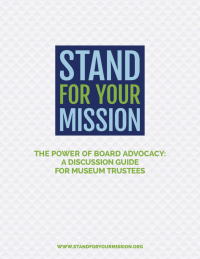
 Every nonprofit has its own unique history, culture, and mission, and, therefore, its own view regarding advocacy. But, no matter where you are on the continuum—from doing no advocacy to doing a lot—the path toward greater impact through advocacy begins with an honest conversation in the boardroom—a conversation about your museum’s mission, goals, and, most importantly, its vision for the future.
Every nonprofit has its own unique history, culture, and mission, and, therefore, its own view regarding advocacy. But, no matter where you are on the continuum—from doing no advocacy to doing a lot—the path toward greater impact through advocacy begins with an honest conversation in the boardroom—a conversation about your museum’s mission, goals, and, most importantly, its vision for the future.
The following guide is designed to help you as a trustee start that conversation. While some organizations may be able to move ahead quickly because they have already grappled with the more fundamental questions presented here, others may want to spend more time on those questions before moving on. Regardless of where your organization starts, we encourage you to use this guide as a tool for facilitating ongoing board dialogue on your organization’s legal right to advocate and for helping you cultivate a culture of standing for your mission in all possible ways.
Step 1: A shared vision for the future
Your organization was founded to meet a specific need or purpose and, as a part of that, is likely to have a vision of what the world would look like if that mission was achieved. Ask your board to answer the following questions:
- Is the board in agreement about our museum’s vision for the future?
- How would the world be different if our mission was fully achieved?
- Are our current strategies the fastest or most direct path to achieving our vision? If not, what would be?
Step 2: A deeper understanding of your work
Skip over related stories to continue reading articleAll organizations are impacted by the larger environment and ecosystem in which they operate. Understanding what that ecosystem looks like for your museum, and where you are situated within it, is a critical step for your board. Ask your board the following questions:
- How is our museum working to address societal realities or challenges that face our community and its citizens?
- How is the work of our museum impacted by broader issues and challenges impacting our community?
- Are our strategies actively addressing those issues? If not, what would change if they did?
Step 3: Identification of the opportunities and threats
Changes in your community, funding sources, and policy environment affect—either positively
or negatively—your museum’s ability to achieve its mission. Identifying and understanding the opportunities and threats affecting your museum is a key step in building an advocacy strategy and in ensuring that your board is well-positioned to help implement that strategy. Ask your board the following questions:
- What are some of the external factors that have positively or negatively impacted our work in the past? How well did we—as a board—anticipate them before they happened? Did we try to stop or soften the bad ones, or rally to support the good ones?
- Are there policy changes that would dramatically improve (or threaten) our ability to fulfill our mission and vision? If we could advance our mission more effectively by changing one law, public policy, or public attitude, what would that change be?
- Do we have candid conversations about the reliability of funding that we earn through government contracts or grants?
- Are we—as an organization—actively engaged in conversations with decision-makers about the policies or decisions that affect our work? If not, why not?
Step 4: Board engagement in making it happen
Every board member brings a potent combination of passion and influence to their board service that—if leveraged—can powerfully accelerate your organization’s advocacy strategy. Understanding your board’s networks and spheres of influence can help you map the ways each board member can help. Ask your board the following questions:
- Do we regularly discuss the implications of public policies and funding to our mission?
- Do we have a public policy strategy for our museum, and—if so—is the board well-informed about how best to support it?
- Do we have board leaders who can speak to and connect with a broad cross-section of community needs and constituencies in support of our work?
- Have we provided training or guidance to board members about how to engage effectively in advocacy efforts that enables them to represent our mission and work with confidence?
Step 5: Making advocacy a part of your board’s culture
A true cultural change happens when advocacy becomes fully integrated into the way that your board thinks, makes decisions, and measures its own success. Ask your board the following questions:
- Do we have goals for our advocacy work that enable us to assess how well we are doing across all the links and connections that are vital to our success?
- Is a degree of advocacy a part of every board member’s job description?
- Is our board recruitment strategy aligned with our public policy strategy, and the connections or influence that will ensure our success?
- Are we—as an organization—actively participating in coalitions and organizations that are helping to advance our advocacy strategy








I’d like to receive the Stand for yoru Mission pdf, please.
Hello Jeannie,
Click on this link to fill in a short form and receive your download. https://www.aam-us.org/programs/advocacy/stand-for-your-mission/
Cecelia Walls